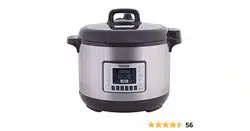Loading ...
Loading ...
Loading ...

28 29
Owner’s ManualOwner’s Manual
PRESSURE CANNING (Continued)PRESSURE CANNING (Continued)
1
4
Liquid Level
1
4
Liquid Level
1 inch
head space
Before pressure canning in the NuWave Nutri-Pot
®
Digital Pressure Cooker,
consult an instructional book written specifically for pressure canning. The
Nutri-Pot can be used for basic pressure canning, along with the water bath
method. Both low- and high-acid fruits and vegetables are recommended. MEAT
AND SEAFOOD ARE NOT RECOMMENDED TO BE PRESSURE CANNED.
Safe Canning Tips:
1. Do not use overripe fruit. Bad quality degrades with storage.
2. Do not add more low-acid ingredients (onions, celery, peppers, garlic, etc.)
than specified in the written recipe. This may lead to an unsafe end result.
3. Don’t use too many spices. Many spices tend to contain high levels of
bacteria, which may result in unsafe canned goods.
4. Do not add butter or fat to the recipe. Fats do not store well and may cause
premature spoilage. Never use thickeners such as flour, starch, pasta, rice
or barley.
5. Use only USDA-recommended tools and accessories.
6. Do add acid (lemon juice, vinegar, or citric acid), especially to tomato
products when directed in the recipe. If necessary, you can balance the tart
taste by adding sugar.
The Nutri-Pot Canning Process
Though your exact experience may vary depending on the specific recipe you
are following, most recipes can be prepared by following this guide.
1. Only follow recipes that have been tested for pressure canning. Prepare the
necessary ingredients as instructed in the recipe.
2. Fill clean, 16-ounce mason jars
to the level. Do not allow ingredients
to exceed the level. Always leave no
less than 1 inch of head space.
3. Gently remove any lingering air
bubbles by pressing a flexible,
nonporous spatula between
the ingredients and the jar itself.
4. Place a clean lid onto each jar, then add
a screw band. Turn the lid clockwise
and tighten in place.
NOTE: Never retighten lids after pressurizing the jars. As the jars cool, the
contents will contract, pulling the lid firmly against the jar to form a high
vacuum and create a seal. If the screw bands are too loose, liquid may
escape from the jars during this process, causing the seals to fail. If the
screw bands are too tight, air cannot vent during this process, causing food
to discolor while in storage.
Tightening the lids too much may also cause the lids to buckle and the jars to
break. Screw bands are not needed on stored jars.
Remove after jars have cooled. When removed, washed, dried and stored,
screw bands may be used many times. If left on stored jars, they become
difficult to remove, often rust, and may not work properly again.
5. Place the Inner Pot in the base unit. Put the Rack in the bottom of the
Inner Pot. Place filled, sealed jars on Rack. Unit will hold up to four
individual 16-oz. jars (maximum).
6. Pour hot water over the jars and into the Inner Pot until the water level
reaches ¼ of the way up the sides of the jars, for four individual 16-oz cans.
This would be about 6 cups of water. When processing fewer jars, more
water would be needed.
1
4
Liquid Level
7. After reading the Owner’s Manual, put the Lid on the base and lock in place.
Plug the unit into the wall outlet.
8. Press “canning”, and the pressure cooker will default to 20 minutes.
To change pressure time, press “time” then adjust accordingly.
9. When the canning process is complete, the unit will shut off. Turn the
Pressure Release Switch to “Release” to release the pressure. Once all the
steam has escaped, carefully open and remove the lid.
10. Using canning tongs, remove the hot jars and place them on a heat-
resistant surface and allow to cool to room temperature.
Loading ...
Loading ...
Loading ...
